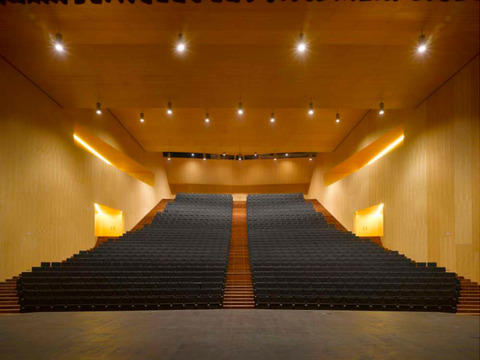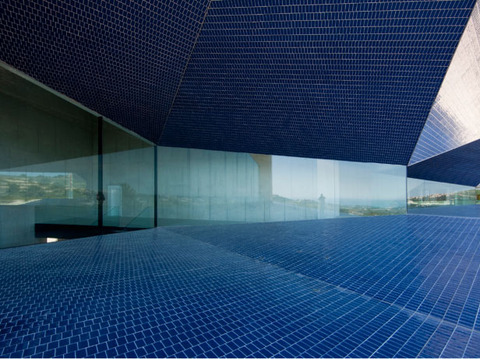Francisco Mangado: architecture by the left hand
November 15, 2011
Francisco Mangado is not a guest who turns up to an event in a superficial way: he likes getting ready in time, knowing who is going to be around, doing what and why. He loves to talk about the Fundaciòn Arquitectura y Sociedad, created by himself in 2008, which in Spain enables professionals from different disciplines to find an interdisciplinary meeting point, that can help the evolution of architecture.
But Professor Francisco Mangado also likes to talk about cooking, tradition, university and books, with the positive energy, which is his trademark; everything with the same readiness to listening and exchanging.
 Swimming pools for the university of Vigo. Orense
Swimming pools for the university of Vigo. Orense Swimming pools for the university of Vigo. Orense
Swimming pools for the university of Vigo. Orense New technologies training center. Santiago de Compostela
New technologies training center. Santiago de Compostela New technologies training center. Santiago de Compostela
New technologies training center. Santiago de Compostela New technologies training center. Santiago de Compostela
New technologies training center. Santiago de Compostela La Balastera. Soccer stadium. Palencia
La Balastera. Soccer stadium. Palencia La Balastera. Soccer stadium. Palencia
La Balastera. Soccer stadium. Palencia La Balastera. Soccer stadium. Palencia
La Balastera. Soccer stadium. Palencia La Balastera. Soccer stadium. Palencia
La Balastera. Soccer stadium. Palencia Gamesa eolica
Gamesa eolica Gamesa eolica
Gamesa eolica Elite equstrian center. Ultzama
Elite equstrian center. Ultzama Elite equstrian center. Ultzama
Elite equstrian center. Ultzama Spanish pavilion Zaragoza
Spanish pavilion Zaragoza Spanish pavilion Zaragoza
Spanish pavilion Zaragoza
At present Professor Mangado teaches in his home country, in Pamplona, and in the elegant city of Losanna, at the Ecole Polytecnique Fédérale, one of the most prestigious institute in Europe.
According to Mangado, to bring society closer to architecture is a fundamental objective to be pursued, but also to be passed on to the students, because “after thirty years of teaching, I realized that the most important aspect of our work is to serve the society, and this is also the aim of the Fundaciòn, where only five members are architects, whereas the others come from the world of politics, sociology, art.”
His conference is dedicated to the students “because making architecture is strictly connected with the teaching profession. Experiencing architecture is not as easy as shown by reviews and media; making architecture by the left hand means to understand the difficulties of this job. New generation needs to realize the risk implied in this discipline, because we, as architects, have confused architecture with architectural object, forgetting the social service of our profession.”
In order to make this statement clearer, he describes five symbolic buildings of his research.
 Exhibition and congress center. Avila
Exhibition and congress center. Avila Exhibition and congress center. Avila
Exhibition and congress center. Avila Exhibition and congress center. Avila
Exhibition and congress center. Avila Exhibition and congress center. Avila
Exhibition and congress center. Avila Exhibition and congress center. Avila
Exhibition and congress center. Avila Exhibition and congress center. Avila
Exhibition and congress center. Avila Exhibition and congress center. Avila
Exhibition and congress center. Avila Archeology museum of Avala. Vitoria
Archeology museum of Avala. Vitoria Archeology museum of Avala. Vitoria
Archeology museum of Avala. Vitoria Archeology museum of Avala. Vitoria
Archeology museum of Avala. Vitoria Archeology museum of Avala. Vitoria
Archeology museum of Avala. Vitoria
The Exhibition Centre of Avila, situated in a relevant and compact historical site, marked by the presence of the walls, brought Mangado to ask himself “how can I deal with the complexity of such a highly compact space? So I decided to manipulate the topography, creating a new piece of landscape.”
A similar experience in the Archaeological Museum of Alava Vitoria presented, from a political point of view, a very delicate situation, as “in this area there are ETA terrorists and immigrants from Africa, so the public administration asked me to build the most important institution, able to give physical and symbolic evidence to the equality of the different social groups or, in brief, no evidence to Basque superiority. So I asked myself: what is an archaeological museum? In my opinion it is something intimate, which shows small pieces, revealing and explaining hundreds of thousands years of history. This is why I thought to rebuild the pieces. Everything has been made by wood and bronze and the facades are very stout, as this is a place of the time.”
About the Spanish Pavilion at Saragossa Expo he reveals us that “at the beginning I did not want to accept the task, because I thought it was a waste of time and money to build ephemeral things, not-lasting structures. There was one more problem, as I was asked to think about water and, in my opinion, this is an extremely risky point in a country like Spain! On the other hand it annoyed me to participate to the creation of a “sustainable style”, a sort of “Environmental Style”, but the idea of showing how Spanish people succeed in negotiating every situation with little, finally tempted me. So a fantastic forest was born. The display was supposed to take place in the cases in the wood. A forest of trees, metal and terracotta covering.”
 Auditorium of Teulada
Auditorium of Teulada Auditorium of Teulada
Auditorium of Teulada Auditorium of Teulada
Auditorium of Teulada Auditorium of Teulada
Auditorium of Teulada Auditorium of Teulada
Auditorium of Teulada Baluarte. Auditorium and congress center of Navarre
Baluarte. Auditorium and congress center of Navarre Baluarte. Auditorium and congress center of Navarre
Baluarte. Auditorium and congress center of Navarre Baluarte. Auditorium and congress center of Navarre
Baluarte. Auditorium and congress center of Navarre Baluarte. Auditorium and congress center of Navarre
Baluarte. Auditorium and congress center of Navarre
Of the Auditorium in Teulada he tells us that this project started many years ago and the most relevant element is about the orographical aspect. In fact in this building is pursued the conceptual, not physical, connection between the built up area and the region. The Mediterranean light is so powerfully strong and predominant, that Mangado had to discover how to guarantee, even in summer, the use of the structure built by concrete. A compact, thick, metaphysical place, which masterfully shows the successful relation between technology and tradition.
Mangado completes the roundup of the projects with a work which he holds dear (his daughter is an equitation champion) and shows his great versatility: the Horse Riding Centre of Ultzama with its rigorous and essential design, which draws, like the symbolic gesture of a child, the cultural and sentimental relationship with this region, with its ground. This space evokes the lesson of the masters of the European Modernism and it reminds that even the most complex spaces can be visually told by a complete simplicity.
According to Mangado even the left hand is able to design absolutely poetical works.
back to top print
Post-it
ISSN 2239-6063
edited by
Alfonso Acocella
redazione materialdesign@unife.it